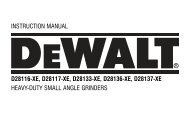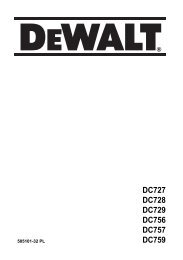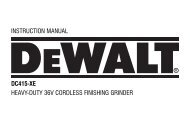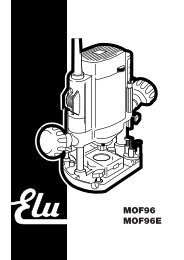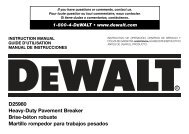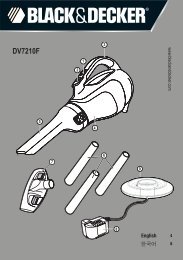kombinasjonssag dw743 - Service - DeWalt
kombinasjonssag dw743 - Service - DeWalt
kombinasjonssag dw743 - Service - DeWalt
You also want an ePaper? Increase the reach of your titles
YUMPU automatically turns print PDFs into web optimized ePapers that Google loves.
ENGLISH<br />
Safety instructions<br />
When using stationary power tools, always observe the safety<br />
regulations applicable in your country to reduce the risk of fire,<br />
electric shock and personal injury.<br />
Read all of this manual carefully before operating the tool.<br />
Save this manual for future reference.<br />
General<br />
1 Keep work area clean<br />
Cluttered areas and benches can cause accidents.<br />
2 Consider work area environment<br />
Do not expose the tool to rain. Do not use the tool in damp or wet<br />
conditions. Keep the work area well lit (250 - 300 Lux). Do not use<br />
the tool where there is a risk of causing fi re or explosion, e.g. in the<br />
presence of fl ammable liquids and gases.<br />
3 Keep children away<br />
Do not allow children, visitors or animals to come near the work area<br />
or to touch the tool or the mains cable.<br />
4 Dress properly<br />
Do not wear loose clothing or jewellery, as these can be caught in<br />
moving parts. Wear protective hair covering to keep long hair out of<br />
the way. When working outdoors, preferably wear suitable gloves<br />
and non-slip footwear.<br />
5 Personal protection<br />
Always use safety glasses. Use a face or dust mask whenever the<br />
operations may produce dust or fl ying particles. If these particles<br />
might be considerably hot, also wear a heat-resistant apron.<br />
Wear ear protection at all times. Wear a safety helmet at all times.<br />
6 Guard against electric shock<br />
Prevent body contact with earthed or grounded surfaces (e.g. pipes,<br />
radiators, cookers and refrigerators). When using the tool under<br />
extreme conditions (e.g. high humidity, when metal swarf is being<br />
produced, etc.), electric safety can be improved by inserting an<br />
isolating transformer or a (FI) earth-leakage circuit-breaker.<br />
7 Do not overreach<br />
Keep proper footing and balance at all times.<br />
8 Stay alert<br />
Watch what you are doing. Use common sense. Do not operate the<br />
tool when you are tired.<br />
9 Secure workpiece<br />
Use clamps or a vice to hold the workpiece. It is safer and it frees<br />
both hands to operate the tool.<br />
10 Connect dust extraction equipment<br />
If devices are provided for the connection of dust extraction and<br />
collection facilities, ensure that these are connected and properly used.<br />
11 Remove adjusting keys and wrenches<br />
Always check that adjusting keys and wrenches are removed from<br />
the tool before operating the tool.<br />
12 Extension cables<br />
Before use, inspect the extension cable and replace if damaged.<br />
When using the tool outdoors, only use extension cables intended for<br />
outdoor use and marked accordingly.<br />
13 Use appropriate tool<br />
The intended use is described in this instruction manual. Do not force<br />
small tools or attachments to do the job of a heavy-duty tool. The tool<br />
will do the job better and safer at the rate for which it was intended.<br />
Do not force the tool.<br />
Warning! The use of any accessory or attachment or performance<br />
of any operation with this tool other than those recommended in this<br />
instruction manual may present a risk of personal injury.<br />
14 Check for damaged parts<br />
Before use, carefully check the tool and mains cable for damage.<br />
Check for misalignment and seizure of moving parts, breakage of<br />
parts, damage to guards and switches and any other conditions that<br />
may affect its operation.<br />
Ensure that the tool will operate properly and perform its intended<br />
function. Do not use the tool if any part is damaged or defective.<br />
Do not use the tool if the switch does not turn it on and off.<br />
Have any damaged or defective parts replaced by an authorised<br />
D E WALT repair agent. Never attempt any repairs yourself.<br />
15 Unplug tool<br />
Switch off and wait for the tool to come to a complete standstill<br />
before leaving it unattended. Unplug the tool when not in use, before<br />
changing any parts of the tools, accessories or attachments and<br />
before servicing.<br />
16 Avoid unintentional starting<br />
Be sure that the tool is switched off before plugging in.<br />
17 Do not abuse cord<br />
Never pull the cord to disconnect from the socket. Keep the cord<br />
away from heat, oil and sharp edges.<br />
18 Store idle tools<br />
When not in use, tools must be stored in a dry place and locked up<br />
securely, out of reach of children.<br />
19 Maintain tools with care<br />
Keep the tools in good condition and clean for better and safer<br />
performance. Follow the instructions for maintenance and changing<br />
accessories. Keep all handles and switches dry, clean and free from<br />
oil and grease.<br />
20 Repairs<br />
This tool is in accordance with the relevant safety regulations. Have<br />
your tool repaired by an authorised D E WALT repair agent. Repairs<br />
should only be carried out by qualifi ed persons using original spare<br />
parts; otherwise this may result in considerable danger to the user.<br />
Additional safety rules for flip-over saws<br />
● Do not allow untrained people to operate this machine.<br />
● Do not use the saw to cut other than aluminium, wood or similar<br />
materials.<br />
● Connect the machine to a dust collection device when sawing wood.<br />
● Select the correct saw blade for the material to be cut.<br />
● Do not use cracked or damaged saw blades.<br />
● Do not use HSS blades.<br />
● Use correctly sharpened blades. Observe the maximum speed<br />
marked on the saw blade.<br />
● Use only saw blades recommended by the manufacturer and which<br />
conform to EN 847-1.<br />
● Do not use the saw without the guards and riving knife in position<br />
and properly maintained, especially when changing from mitre saw<br />
mode to bench saw mode, or vice versa.<br />
● Make sure the fl oor area around the machine is level, well<br />
maintained and free of loose materials, e.g. chips and cut-offs.<br />
● Make sure adequate general or localized lighting is provided.<br />
● Wear suitable personal protective equipment when necessary,<br />
including:<br />
– hearing protection to reduce the risk of induced hearing loss;<br />
– respiratory protection to reduce the risk of inhalation of harmful dust;<br />
– gloves for handling saw blades and rough material. Saw blades<br />
should be carried in a holder wherever practicable.<br />
● Refrain from removing any cut-offs or other parts of the work piece<br />
from the cutting area while the saw is running and the saw head is<br />
not in the rest position.<br />
● Replace the table insert when worn.<br />
● Report faults in the machine, including guards or saw blades, to your<br />
dealer as soon as they are discovered.<br />
● Ensure that the upper portion of the saw blade is completely<br />
enclosed in the mitre sawing mode.<br />
● Ensure that the arm is securely fi xed in the working position in the<br />
bench sawing mode.<br />
● Ensure that the arm is securely fi xed when bevelling in the bench<br />
saw mode.<br />
31






